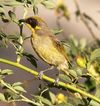Genus Lichenostomus
Yellow-faced honeyeater - The Yellow-faced Honeyeater inhabits the east coast of Australia from northern Queensland to the coast of South Australia. Its primary habitat is open forests and woodlands but it is also found in parks in urban areas. It will also inhabit rainforests and mangrove forests. Across its range it occurs from sea level to the subalpine zone.
Purple-gaped Honeyeater - Its natural habitat is Mediterranean-type shrubby vegetation.
Mangrove Honeyeater - It is endemic to Australia, where it is restricted to the eastern coast from Townsville in Queensland to northern New South Wales. The species has been expanding its range southward in recent years. The mangrove honeyeater is generally locally common over most of its range, but is rarer in the south.
Yellow-throated Honeyeater - The species was originally described by French ornithologist Louis Jean Pierre Vieillot in 1817, who originally placed it in the genus Melithreptus. Its specific epithet is derived from the Latin words flavus "yellow", and collis "neck". Other vernacular names are the Green Cherry-picker, Green Dick or Green Linnet.
Yellow Honeyeater - Its natural habitats are subtropical or tropical moist lowland forests and subtropical or tropical mangrove forests.
Bridled Honeyeater - The Bridled Honeyeater is a species of bird in the Meliphagidae family. It is endemic to Australia.
Fuscous Honeyeater - Its natural habitat is subtropical or tropical dry forests.
Eungella Honeyeater - Its natural habitat is subtropical or tropical moist lowland forests.
White-eared Honeyeater - It has a noticeable white splash behind the eyes, the 'ears', on a mainly black head, throat and beak. The top of the head is a dark grey colour. The body is a green colour, shading to a softer yellow underbelly.
Yellow-tufted Honeyeater - It was initially described by ornithologist John Latham in 1802 and given several names, initially Muscicapa auricomis and later Turdus melanops. The latter name was retained as a nomen protectum and the former a nomen oblitum as the epithet melanops has been used consistently for over a century. It belongs to the honeyeater family Meliphagidae. More recently, DNA analysis has shown honeyeaters to be related to the Pardalotidae, and the Petroicidae in a large corvid superfamily; some researchers considering all these families in a broadly defined Corvidae.
Obscure Honeyeater - Its natural habitats are subtropical or tropical moist lowland forests and subtropical or tropical moist montanes.
Yellow-plumed Honeyeater - Its natural habitats are temperate forests and Mediterranean-type shrubby vegetation.
White-plumed Honeyeater - The cup nest
Grey-fronted Honeyeater - Its natural habitat is Mediterranean-type shrubby vegetation.
Black-throated Honeyeater - The Black-throated Honeyeater is a species of bird in the Meliphagidae family. It is found in Indonesia and Papua New Guinea. Its natural habitat is subtropical or tropical moist montanes.
White-gaped Honeyeater - Its natural habitats are subtropical or tropical moist lowland forests and subtropical or tropical mangrove forests.
Varied Honeyeater - The Varied Honeyeater is a species of bird in the Meliphagidae family. It is found in Australia, Indonesia, and Papua New Guinea. Its natural habitat is subtropical or tropical mangrove forests.
Singing Honeyeater - Singing Honeyeaters are commonly found in Western Australia, mainly past the Great Dividing Range and on Western Australian Coastal Islands. They can also be spotted in city parks, gardens and in bushlands.







